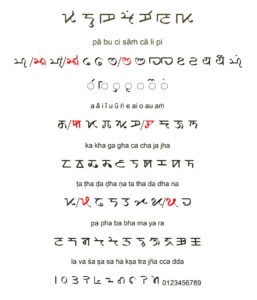Scripts for Divination
The Sancha Lipi—that is, Sancha scripts—are a family of related scripts from northern India. They were brought to my attention by the ever-vigilant Biswajit Mandal.
An elementary teacher from Port Blair, Andaman & Nicobar Islands, he is also a linguist, font creator, and linguistic content supplier for Omniglot and the Endangered Alphabets. He was one of the co-authors of the Mundari Bani Unicode proposal, and he is working on Unicode proposals for the Khema, Chisoi, Ol Onal and Kirat Rai scripts. He has created several fonts for endangered and emerging scripts, including Kamrupi, Chisoi, and Maru-Gujri, and he has recently created the first-ever Pabuchi Sancha font.
It was the appearance on Twitter of his post of the Pabuchi Sancha font that prompted me to ask him more about this remarkable and nearly-vanished script family. He responded:
The scripts are roughly 1500-1800 years old. When a king from Himachal Pradesh married a queen from Kashmir, she brought some scholars to Himachal Pradesh who were extremely talented in astrology, astronomy and fortune telling. They brought with them from Kashmir their writing system, the Old Sharada script, so all the Sancha scripts had that common ancestry. Their divination involved Sancha, or astrological charts and diagrams, so this style is called Sancha Vidhya, and the scripts are called Sancha Lipi.
Later on, the astrologers settled in various parts of the region that is now Himachal Pradesh and Uttarakhand, and when they started their work, they tried to transliterate their knowledge into the local languages. This is why, over time, several local scripts or variants developed for Sancha Vidhya: Pabuchi, Pandwani, Bhttakshari, Chindwani, Bagoi, etc. They all had certain similarities, but in most cases they were also different.
The Sancha texts were written in an unknown language, now no longer used except by these astrologers and their descendants know it, and it is not shared with outsiders, only their family members. Nevertheless, they want to preserve it. Today, an estimated 2000 Sancha books exist, and are still being used for divination.
Here is his Pabuchi Sancha Lipi font:

He also sent links to two YouTube videos about the Sancha texts and tradition:
https://www.youtube.com/watch?v=uC7zjFgtTco
https://www.youtube.com/watch?v=b9rhXZA-3Xo
If you have any more information about any of the Sancha scripts—or any minority script, especially if it is not yet in our Atlas—please reply to this post or email me at tim@endangeredalphabets.com.
This post is sponsored by our friends at Typotheque, Rosetta, and Solidarity of Unbridled Labour.




